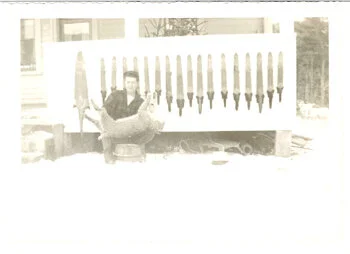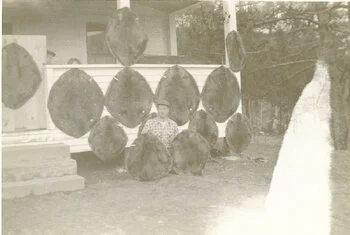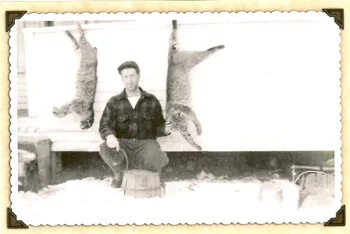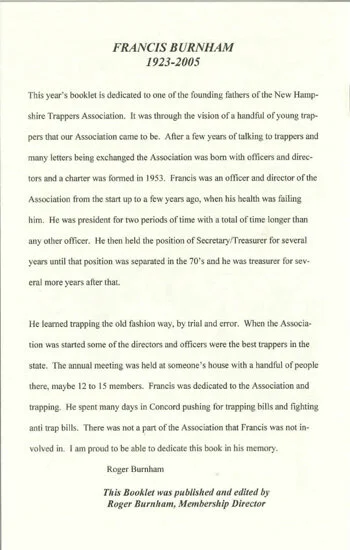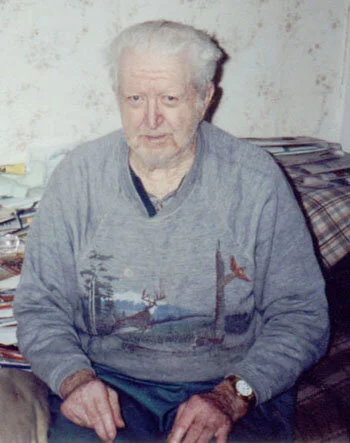Francis Burnham
Inducted into the NHTA Hall of Fame in 1994.
A Founding Father of the NH Trappers Association: As told by past president, Mel Liston.
It’s a sunny afternoon in January 2001, one of those occasions when the roads are melted and dry, the sky is clear, bad weather a few days behind us, a chance to do something before the next winter assault. I called my friend Roger Burnham, Grafton County Director of the New Hampshire Trappers Association, to see if we might go visit his dad in Rumney.
Rogers parents Francis and Dorothy Burnham were at home and they were feeling up to company, so we headed on over. We found Francis on the front porch putting out sunflower seeds for the birds. Francis at age 77 is slowed down considerably since his prime, bucking an assortment of age-related ailments, and significant hearing loss. We all settled in the living room gathered around the wood stove.
Slowly we drifted back through the good times and bad capturing a story of a husband and a dad, of a man who has always been a trapper, and a rugged individual who has made a world of difference for the rest of us trappers in New Hampshire
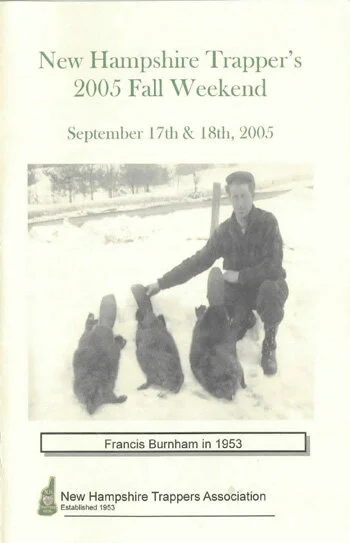

Francis Burnham was born 1923 a quarter mile down the road from where he now lives in Rumney. Like so many men of his era wrapped in the arms of rural America, he started trapping very young. With rusted hand-me-down footholds and homemade box traps, Francis was sharpening his skills for a life long endeavor.
Woodchucks, hedgehogs, muskrats, and skunks were all falling victim to the youthful trapper, before he completed his first decade. Country-boys back then learned how to survive, they shouldered a lot of responsibility at an early age, and they grew up quick. Whatever opportunities there were around and about Rumney, the dreams and aspirations of a young man, were all overshadowed by Nazis gone mad in Europe and sabers rattling in the Pacific.
Francis had his heart set on Dorothy whom he had met at a Grange meeting. Dorothy already had a boyfriend and didn’t particularly like Francis, said he was pesky. Well that pesky Francis stuck with it, slowly wearing Dorothy down. The day would come when Dorothy would no longer deny her affection, and they were married in November 1942.
With the full-blown world war ragging, a whole generation of young men from all over America answered the call to duty. Francis would be leaving to join the Navy. Dorothy was in a motherly way and their first of four children would be born while Francis was in training to become a Seabee.
Roger would be that first-born son with two brothers and a sister to come along in the years to follow. Francis served his country, first in the Islands of the South Pacific then was transferred to Alaska, where one memory was of a Polar Bear he observed out on the frozen bay.
Francis returned to Rumney after the war and would forever after work to support his family as a carpenter and a trapper. Carpentry was good when it was available but often there was no work especially in the fall and winter. The Burnham family knew a lot of lean times. Trapping often took the edge off the hardship. Hunting for meat and trapping for cash was about the only option. Francis had to work at trapping and make it pay.
Muskrat and fox were worth a dollar, coons were worth four dollars, but mink were worth twenty-five dollars, so Francis specialized in mink and would average better than forty per season. The trapline was always for mixed species. When fisher and beaver were legal Francis went after them. A winter’s catch often included a few weasels. Due to unregulated trapping in the distant past plus changes in the habitat, beaver had been totally protected for a long time.
The advent of modern wildlife management ushered in the era of the beaver’s return to viability. Once again a sustainable harvest of beaver was appropriate and beneficial. The first two or three years of the renewed beaver harvest saw short seasons with limits of five beaver per trapper. The fur buyers measured beaver pelts in inches from top to bottom and side to side with the two measurements added together, then multiplied by one dollar per inch. Beaver pelts were worth serious money and Francis trapped his share.
Francis would trap three to five bobcats annually for the bounty, which was originally twenty dollars, then lowered to fifteen, then dropped. Once Francis caught a live bobcat and sold it to the Polar Caves tourist attraction for fifty dollars. They put it in a display cage that wasn’t up to the job and it escaped within the week. Back before fish and game allowed fisher trapping in his part of the state they got so thick that Francis remembers releasing fourteen from his trapline in a single season.
I asked Francis if he ever had any run-ins with the game wardens?
He said, “No.”
I said, “You mean they never caught you?”
He said, “I ain’t saying. I sure did get caught by my own traps a time or two though. Fair amount of finger snapping in the small footholds and occasionally got mixed up with a conibear trap. Once had Roger along when he was a teenager. Got my arm clamped in a 330 Conibear. Roger was on the opposite side of the river with no hip boots, so I had to pull out by myself. That hurt for a long time. Broke through the ice a few times, never life threatening, but once on the Indian River I had to climb a twelve foot shear bank to get out. I always knew I would make it, but after falling back in a few times, it was discouraging.”
“I trapped all over Grafton county” Says Francis.
“And I knew more people personally because of my trapping than I ever would have otherwise. There were peculiar arrangements with landowners in exchange for permission to trap. Like them folks from Ohio who settled in Warren, NH and granted permission to trap in exchange for muskrat meat.”
Francis did all his own skinning and fur handling, he saved animal glands for lure making, saved porcupine livers for bobcat bait, and chopped up bobcat meat for fox bait. During the trapping season animal carcasses were piled in different places out back of the house. Needless to say one of his best trapping locations was right around the house. Besides catching a variety of critters in the back yard he caught all of his young boys one time or another.
Back in the sixties, Fransis got the hold on a big cat in one of his fox sets. The trap was way to small, and the cat pulled free. Based on what he saw he figured it must have been a Lynx or a mountain Lion, he will never know for sure. One thing he does know for sure is that he saw a mountain lion with a jackrabbit in its mouth on Route 118 in Dorchester a few years later. Fransis was returning from his trapline after dark and the big cat stood in the road under his headlights long enough for him to be convinced it was a mountain lion.
After World War II there was a national awareness by many segments of society as to the benefits of unions, associations, trade organizations, etc. Trappers have always been a secretive, independent, and competitive mix of individuals, but in spite of their differences they began to see the value of being organized and working together on issues of common concern.
State or regional trapping organizations, associations, or clubs began to crop up around the country. In 1953 Lyle Prior, Francis Burnham, and a few others got together and founded the New Hampshire Trappers Association. Initially membership cost one dollar. They elected Lyle Prior the first president, and he served a two-year term. The NHTA elected Francis to be the second president. Francis served as president quite a few years then as secretary ten again as president.
Originally the NHTA had only one meeting per year in the fall and it was partially business and part socializing. Francis remembers fondly how each year he would bring a good supply of cranberry shell beans from his garden to swap with another trapper Octave Delude for muskmelons. Francis often swapped beaver carcasses for fisher lure with Malcolm Locke the famous fox and fisher trapper from the Barnstead/Alton area.
There was a professional lure maker named Noel Stendor who really wanted to get his hands on some of Malcolm’s fisher lure. Francis remembers once when he, Lyle Prior, Malcolm Locke, and Noel were all sitting around with Noel passing the hard stuff and trying to pry some fisher lure secrets out of Malcolm. Yea they had fun, but they did business too. Francis says it took about ten years to get a good relationship going with Fish and Game, but eventually they both found themselves on the same side of an issue before the legislature and things have remained friendly ever since.
Francis Burnham and Lyle Prior both held lifetime memberships in the NHTA and each has been inducted into the trappers Hall of Fame for their early devotion to the NHTA and their hard work as founding fathers. Lyle passed away in 2000 as did Malcome Locke. Francis’s old friend Octave Delude has been gone for a while also. Many of the old trappers are gone and sadly some of their names are lost to us, but some of their memory lives on in the present generation of trappers who have inherited their old territory. This author traps a portion of what was once Malcolm Locke’s trapline. There are landowners that remember Malcolm well and there are many stories. It is not uncommon for a landowner to take me out on their property and show me the exact locations that Malcolm would use, year after year, to set his fox traps.
Francis trapped every season until two years ago when he had to give it up due to health conditions; he stands out as one of the few remaining old time trappers. We will savor whatever time we have left with this ole man of trapping who was our founding father and we will remember always what he has given us.
